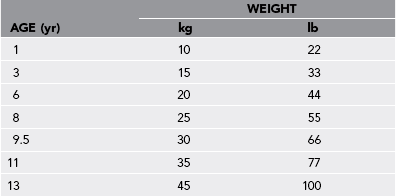Children in the Wilderness
What Makes Children Different
1. Medications and fluids must be calculated on the basis of the weight of the child (Table 62-1). One should also be aware of normal ranges of vital signs according to age (Table 62-2).
Table 62-1

From U.S. Centers for Disease Control and Prevention, National Center for Health Statistics (http://www.cdc.gov/nchs/).
Table 62-2
Age-Specific Resting Heart Rate and Respiratory Rate*
| AGE | HEART RATE (Beats/Min) | RESPIRATORY RATE (Breaths/Min) |
| 0-5 mo | 140 ± 40 | 40 ± 12 |
| 6-11 mo | 135 ± 30 | 30 ± 10 |
| 1-2 yr | 120 ± 30 | 25 ± 8 |
| 3-4 yr | 110 ± 30 | 20 ± 6 |
| 5-7 yr | 100 ± 20 | 16 ± 5 |
| 8-11 yr | 90 ± 30 | 16 ± 4 |
| 12-15 yr | 80 ± 20 | 16 ± 3 |
2. Children experience greater toxicity from envenomation because of the increased dose of venom per kilogram of weight.
3. Children are more likely to have incomplete “greenstick” fractures or injuries involving the growth plates.
4. Children are more susceptible to blunt chest and abdominal injuries due to their height and flexible ribs, which affords less protection of internal organs.
5. Children experience greater exposure to environmental factors such as cold, heat, and solar radiation because they have a larger body surface area–to–mass ratio than do adults.
6. Thermoregulation is less efficient in children, making them more susceptible to heat illness and hypothermia.
7. Children experience a greater number of infections than do adults.
8. Children are at greater risk for dehydration than are adults.
9. Small children tend to explore their environment with hands and mouths.
Age-Specific Expectations for Wilderness Travel
Table 62-3
Age-Specific Expectations for Wilderness Travel
| AGE | EXPECTATION | SAFETY ISSUES |
| 0-2 yr | Distance traveled depends on adults Use child carriers |
Provide “safe play area” (e.g., tent floor, extra tarp laid out), bells on shoes |
| 2-4 yr | Difficult age; stop every 15 min, hike 1-2 miles on own | Dress in bright colors, teach how to use whistle |
| 5-7 yr | Hike 1-3 hr/day, cover 3-4 miles over easy terrain, rest every 30-45 min | Carry whistle (three blows for “I’m lost”), carry own pack with mini first-aid kit and water |
| 8-9 yr | Hike a full day with easy pace, cover 6-7 miles over variable terrain; if over 1.2 m (4 feet) tall, can use framed pack | As for 5-7 yr, plus teach map use and route finding, precondition by increasing maximal distances by <10%/wk, watch for overuse injuries, keep weight of pack <20% of bodyweight |
| 10-12 yr | Hike a full day at moderate pace, cover 8-10 miles over variable terrain | As for 8-9 yr; expand route planning role, compass use |
| Teens | Hike 8-12 miles at adult pace; may see a decrease in pace or distance with growth spurt | As for 10-12 yr, but expand survival and wilderness first-aid knowledge. |






